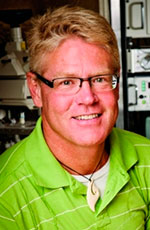At the moment of birth, the essential role of delivering life-saving oxygen to the baby switches from mom and her placenta to the baby’s lungs and brain. That the timing of this happens so precisely is miraculous, but how it happens remains largely a mystery.
New research from the University of Virginia School of Medicine, in partnership with investigators from the University of Alberta, sheds light on how brain changes activated at birth protect baby’s breathing – and may even offer important insights into sudden infant death syndrome (SIDS).

Greg Funk, a physiology professor in the U of A’s Faculty of Medicine & Dentistry, and PhD students Robert Reklow and Yong Zhang, in a project led by their U.S. counterparts, discovered a signalling system within the brain stem that activates with the baby’s first breaths to support early breathing.
“Prior to birth, baby’s oxygen demands are met entirely by mom and mom’s placenta,” said Funk, who is also a member of the U of A’s Neuroscience and Mental Health Institute. “At birth, this immediately has to switch. All of a sudden the maternal system has to turn off and the baby’s lungs and brain have to take over gas exchange. However, these brain networks that take over are still immature and can generate unstable breathing.
“We think this signalling system is a safety factor in the brain that helps stabilize breathing at this critical time.”
The findings help researchers understand how breathing transitions from a fragile state susceptible to brain-damaging and potentially deadly pauses early in the baby’s development to a stable and robust physiological system that flawlessly supplies the body with oxygen for the rest of our lives.
Before a baby is born, breathing is not required and breathing movements occur only intermittently, so the transition at birth can be a highly vulnerable period.
The researchers found that a specific gene is turned on immediately at birth in a selective cluster of neurons that regulate breathing. This gene encodes a peptide neurotransmitter – a chain of amino acids that relays information between neurons. This transmitter, called PACAP, starts to be released by these neurons just as the baby emerges into the world. The scientists determined that suppressing the peptide causes breathing problems and increases the frequency of apneas – potentially dangerous pauses in breathing. These apneas further increased with changes in environmental temperature.
The observations suggest that problems with the neuropeptide system may contribute to SIDS.
SIDS, also known as cot death, is the sudden unexplained death of a child less than one year old. It is the leading cause of infant mortality in Western countries. SIDS is attributed to a combination of genetic and environmental factors, including temperature. The new research suggests problems with the neuropeptide system may increase babies’ susceptibility to SIDS and other breathing problems.
PACAP is the first signalling molecule shown to be massively and specifically turned on at birth by the breathing network, and it has been linked genetically to SIDS. The researchers noted there may be other important factors to discover that can shed more light on the causes of SIDS.
“These findings raise the interesting possibility that additional birth-related changes may occur in the control systems for breathing and other critical functions,” said Douglas Bayliss, chair of UVA’s Department of Pharmacology. “We wonder if this could be a general design principle in which failsafe support systems are activated at this key transition period, and that understanding those may help us better treat disorders of the newborn.”
Funk’s work is supported by the Canadian Institutes of Health Research, Canada Foundation for Innovation and Stollery Children’s Hospital Foundation through the Women and Children’s Health Research Institute.
The study, “A brainstem peptide system activated at birth protects postnatal breathing,” was published in Nature.
| By Michael Brown
Folio, a Troy Media content provider partner, is the University of Alberta’s online publication.
The views, opinions and positions expressed by columnists and contributors are the author’s alone. They do not inherently or expressly reflect the views, opinions and/or positions of our publication.
